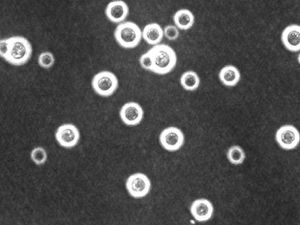Cryptococcus neoformans: Difference between revisions
| Line 59: | Line 59: | ||
==Epidemiology== | ==Epidemiology== | ||
[[Image:hivcryptoneo.jpg|thumb|300px|left|Global burden of HIV-related cryptococcal meningitis. From: http://www.cdc.gov/fungal/diseases/cryptococcosis-neoformans/statistics.html | |||
A close correlation between the occurrence of ''C. neoformans'' and pigeon droppings has been shown [[#References|[1000]]]. ''C. neoformans var. grubii'' has a worldwide distribution with the most cases being reported in the United States and Australia, while ''C. neoformans var. neoformans'' is is mostly restricted to France, Italy, and Denmark [[#References|[1500]]]. Among immmunocompetent individuals, groups at risk are the elderly and those using corticosteroids [[#References|[1000]]]. In the United States, only 25% of infections are reported among immunocompetent individuals [[#References|[3500]]]. Among HIV/AIDS patients, it is estimated that approximately 957,900 cases occur each year, resulting in nearly 625,000 deaths [[#References|[2000]]]. Worldwide, 7-10% of patients with AIDS are affected [[#References|[2000]]]. AIDS-associated cryptococcosis accounts for 50% of cryptococcal infections reported worldwide, usually occurring in HIV patients when their CD4 lymphocyte count falls below 200/mm3. In sub-Saharan Africa, the mortality rate is estimated to be between 50-70% . In developed countries such as the United States where therapy is available, the mortality rate is as low as 12% [[#References|[2000]]]. | A close correlation between the occurrence of ''C. neoformans'' and pigeon droppings has been shown [[#References|[1000]]]. ''C. neoformans var. grubii'' has a worldwide distribution with the most cases being reported in the United States and Australia, while ''C. neoformans var. neoformans'' is is mostly restricted to France, Italy, and Denmark [[#References|[1500]]]. Among immmunocompetent individuals, groups at risk are the elderly and those using corticosteroids [[#References|[1000]]]. In the United States, only 25% of infections are reported among immunocompetent individuals [[#References|[3500]]]. Among HIV/AIDS patients, it is estimated that approximately 957,900 cases occur each year, resulting in nearly 625,000 deaths [[#References|[2000]]]. Worldwide, 7-10% of patients with AIDS are affected [[#References|[2000]]]. AIDS-associated cryptococcosis accounts for 50% of cryptococcal infections reported worldwide, usually occurring in HIV patients when their CD4 lymphocyte count falls below 200/mm3. In sub-Saharan Africa, the mortality rate is estimated to be between 50-70% . In developed countries such as the United States where therapy is available, the mortality rate is as low as 12% [[#References|[2000]]]. | ||
Revision as of 16:51, 28 July 2015


Etiology/Bacteriology
Higher order taxa
Eukaryota (Kingdom); Fungi (Domain); Basidiomycota (Phylum); Tremellomycetes (Class); Tremellales (Order); Tremellaceae (Family); Cryptococcus (Genus)
Species
C. neoformans v. grubii (serotype A), C. neoformans v. neoformans (serotype D). Its teleomorph is Filobasidiella neoformans. A third variety, once known as C. neoformans v. gattii, is now considered a distinct species, Cryptococcus gattii.
|
NCBI: Taxonomy Genome: Cryptotoccus neoformans |
Description
Cryptococcus neoformans is a spherical, encapsulated, non-myceliated, non-fermenting fungal cell [500]. Among pathogenic fungi, C. neoformans is unique in that it possesses a mucinous capsule. Small-sized basidiospores (1.8 to 3.0 μm) can turn into yeast cells, the form preferred at 37°C, or can form dikaryotic hyphae which are favoured at 24°C [2500]. C. neoformans causes fatal meningitis primarily in immunosuppressed humans. It is usually found in tissues in the yeast form. Besides a prevalent asexual life cycle, C. neoformans also presents a bipolar mating cycle with two mating types, MATa and MATα, with the latter being the most prevalently isolated from hosts and the environment. Filobasidiella neoformans is the teleomorph (sexual state). During sexual recombination, either filaments with clamp connections or basidiospores are produced. Recombinant basidiospores are produced via same-sex mating and are thought to be the propagules responsible for infection.
Genome structure
Most isolates of Cryptococcus neoformans are haploid. The size of its genome is approximately 19 Mb with 14 chromosomes. C. neoformans has a defined sexual cycle involving mating between cells of the MATa and MATα types. Thus, classical genetic approaches can be applied to study this organism.
Pathogenesis
Transmission
An environmental survey found that Cryptococcus neoformans was isolated from pigeon and other bird excreta and less frequently in other environmental and veterinary (cat, dog, horse, sheep, cow) sources [2000]. The organism exists as both free-living and in association with a variety of hosts [3500]. The primary mode of transmission is inhalation of spores from the environment, affecting both humans and other domestic and wild animals. Transmission from humans and other animals has not been documented.
Infection and incubation
Once C. neoformans spores have been inhaled, infection begins. One key requirement for its persistence is the ability to adapt to the host's physiological conditions. In strains where physiological conditions do not inhibit growth, pathogenicity is determined by the CNA1 gene encoding calcineurin A. Calcineurin A is a Ca2+-calmodulin-regulated protein phosphatase activated by a stress response. Calcineurin A dephosphorylates a group of proteins, allowing for growth at 37°C. Deletion of CNA1 also demonstrates a decreased sensitivity to elevated CO2 and alkaline pH characteristic of host tissues. This indicates that the calcineurin pathway regulates several crucial survival responses.
Cerebral infection and survival
Different routes of infection have been demonstrated in different models. Paracellular and transcellular mechanisms of crossing the endothelial microcapillary wall, as well as in a phagocytosed form using monocytes as "Trojan horses" have been demonstrated as a means of invasion of the central nervous system. Presently it is not clear which mode of infection is preferred, though the microbe's ability to utilize different routes likely contributes to its high propensity to affect the CNS. In the brain, adaptations associated with persistence in the brain include a shift from high (lungs) to low (brain) oxygen and opposition to local host defenses.
Paracellular route
It has been suggested that, following sequestration in cerebral capillaries, damage to endothelium is caused by changes in cryptococcal capsule structure and cell size. It has also been demonstrated that C. neoformans can utilize the host plasminogen system to enhance degradation and invasion of tissues and penetrate the blood-brain barrier. Studies have linked the importance of cryptococcal urease to CNS invasion.
Transcellular route
Studies indicate that C. neoformans is capable of migrating through the endothelium monolayer through transcytosis. The interaction between hyaluronic acid produced by C. neoformans and endothelium CD44 is required for optimal contact to induce transcytosis. Transcytosis is accompanied by activation of protein kinase C-a and is co-localization with actin filaments. This is followed by cytoskeletal arrangements which contribute to the migration of C. neoformans.
"Trojan horse" route
The ability for C. neoformans to utilize monocytes as a passenger allows it to migrate to the brain while also depleting the host of its blood phagocytes.
Virulence factors

Cell enlargement
The size of cells are typically 5-10µm in diameter. However, cell enlargement has been observed in vivo, producing cells up to 100µm in diameter, making it rare for phagocytosis to occur. It is thought that these morphological changes affect pathogenicity via reducing phagocytosis, increasing resistance to oxidative and nitrosative stress, correlating with reduced penetration of the central nervous system. Cell enlargement is stimulated by coinfection with strains of the opposite mating type, and ste3aΔ pheromone receptor mutant strains had reduced cell enlargement. DNA analysis shows that these enlarged cells are polyploid, uninucleate, and capable of producing daughter cells in vivo.
Capsule
The capsule itself can mediate immune evasion through several different mechanisms. The capsule, made up of polysaccharides rich in mannan residues, is strongly hydrophobic in nature. This helps prevent contact with exogenous factors and prevents recognition by some cells of the immune response. It also prevents efficient antibody binding and the resultant activation of the complement system via classical pathway. The capsule is also capable of interacting directly with components of the immune system, namely glucuronoxylomannan (GXM) and galactoxylomannan, both of which are capable of inducing leukocyte activation and cytokine production. However, the capsular anti-inflammatory properties outweigh the inflammatory properties of these two components. Stimulation with encapsulated cryptococci downregulate the activity of macrophages, dendritic cells, and neutrophils. This is associated with reduced inflammatory cytokine and chemokine production. GXM has also been shown to stimulate production of the inflammatory cytokine IL-10 and decrease production of pro-inflammatory cytokines. The capsule is also capable of accelerating degradation of the complement component C3b, as well as apoptosis through upregulation of FasL on APCs such as macrophages. Although these mechanisms do not prevent immunological recognition, they effectively provide a larger window of opportunity to upregulate its own mechanisms to enhance long-term survival in the host.
App1
Secreted cryptococcal protein App1 inhibits phagocytosis through a complement-mediated mechanism, and deletion of App1 improves phagocytosis by alveolar macrophages. App1 blocks complement 3 and complement 2 receptors (CR3 and CR2), interfering with phagocytosis [3500]
Modulation of the adaptive immune response
C. neosporans is also capable of altering the adaptive immune response, which is crucial for long-term persistence. C. neosporans expresses a variety of mechanisms for this purpose: T-cell inhibition and apoptosis, promotion of a nonprotective Th2 response, interference with dendritic cell development, inhibition of protective Th17 response, induction of immune tolerance, and interference with antibody production. High virulence in certain strains has been linked with their ability to strongly induce IL-10, inhibiting development of Th1 responses and promoting tolerogenic responses.
Epidemiology
[[Image:hivcryptoneo.jpg|thumb|300px|left|Global burden of HIV-related cryptococcal meningitis. From: http://www.cdc.gov/fungal/diseases/cryptococcosis-neoformans/statistics.html A close correlation between the occurrence of C. neoformans and pigeon droppings has been shown [1000]. C. neoformans var. grubii has a worldwide distribution with the most cases being reported in the United States and Australia, while C. neoformans var. neoformans is is mostly restricted to France, Italy, and Denmark [1500]. Among immmunocompetent individuals, groups at risk are the elderly and those using corticosteroids [1000]. In the United States, only 25% of infections are reported among immunocompetent individuals [3500]. Among HIV/AIDS patients, it is estimated that approximately 957,900 cases occur each year, resulting in nearly 625,000 deaths [2000]. Worldwide, 7-10% of patients with AIDS are affected [2000]. AIDS-associated cryptococcosis accounts for 50% of cryptococcal infections reported worldwide, usually occurring in HIV patients when their CD4 lymphocyte count falls below 200/mm3. In sub-Saharan Africa, the mortality rate is estimated to be between 50-70% . In developed countries such as the United States where therapy is available, the mortality rate is as low as 12% [2000].
Clinical features
Diagnosis
Diagnostic features are difficult to distinguish, as visible findings such as skin, pulmonary, or bone lesions seen on X-ray are also characteristic of histoplasmosis, toxoplasmosis, and tuberculosis. A CT scan or MRI of the brain may show areas of possible infection, although many other diseases present similar findings as well. Serological testing of spinal fluid may be used if the patient is suspected to have an infection. Definitive diagnosis depends on isolation of the fungus from the patient's tissue or bodily fluids or identification from tissue biopsy samples. Further analysis, such as PCR, may distinguish whether the infection is caused by C. neoformans or C. gattii [2750].
Treatment
In healthy individuals, treatment is usually not necessary. Still, it is recommended to receive check-ups for up to monitor any spreading of the infection. If there are lung lesions or the disease spreads, antifungals such as fluconazole, itraconazole, and voriconazole may be prescribed to clear the infection. Patients with severe lung infections or infections of the central nervous system are recommended to take amphotericin B in combination with flucytosine. In some cases, surgery may be necessary to remove fungal growths (cryptococcomonas) [3000].
Prevention
Host immune response
Damage-response framework
References
500. http://journals.plos.org/plospathogens/article?id=10.1371/journal.ppat.1000953
1000. http://digital.library.okstate.edu/oas/oas_pdf/v45/p277_281.pdf
1500. http://www.mycology.adelaide.edu.au/Fungal_Descriptions/Yeasts/Cryptococcus/C_neoformans.html
2000. http://www.hindawi.com/journals/scientifica/2013/675213/
2500. http://www.phac-aspc.gc.ca/lab-bio/res/psds-ftss/cryptococcus-eng.php
2750. http://www.emedicinehealth.com/cryptococcosis/article_em.htm
3000. http://www.cdc.gov/fungal/diseases/cryptococcosis-neoformans/
3500. http://www.medscape.com/viewarticle/727725
Created by Chris Vu, student of Tyrell Conway at the University of Oklahoma.
